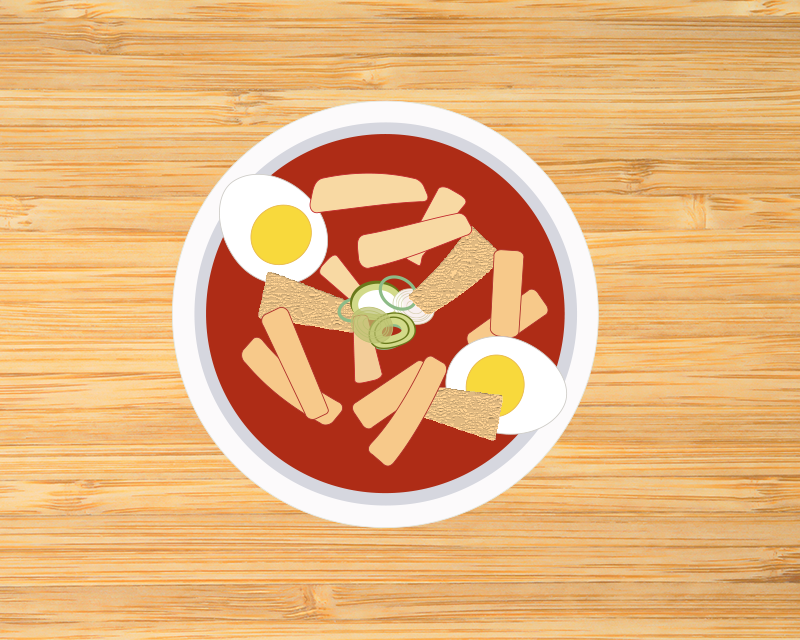By YOUNGSEO JHE & ANDREA KWON
An assortment of vegetables along with rice cakes are neatly placed on the pan as the fire underneath heats the ingredients to the desired temperature. In the middle of it all, the fiery red sauce of tteokbokki (spicy Korean rice cake) slowly melts, creating the perfect sweet and spicy taste of the dish. With the savory scent that surrounds the atmosphere, the sound of the boiling tteokbokki torments the waiting customers.
As a well-loved dish for many Koreans, tteokbokki appears in nearly every street in all different types of restaurants, even food trucks. Despite its current popularity, tteokbokki used to be an upper-class commodity only available with soy sauce rather than the spicy red pepper paste that many are familiar with. First popularized after the Korean War with the mass production of flour, tteokbokki became the favorite food of thousands of Koreans, regardless of age or sex. As such, there are many restaurants and food trucks with unique types of tteokbokki. Among them, Mukshidonna, a popular restaurant chain, is a must-visit for tteokbokki lovers.
Among the numerous Mukshidonna restaurants in Seoul, we chose to visit the one located near the CGV movie theater near Apgujeong station. As soon as we walked in, the sweet and spicy scent of tteokbokki tickled our noses. The waiters and waitresses welcomed us to our seats. Two small plates were set before us, one filled with kimchi and the other with yellow pickled radish. Our server put down a notepad on the table, where we checked off what we wanted to eat. Around ten minutes after our order, the waitress set down a pan of boiling tteokbokki on our table, and we waited a few more minutes in patience for the dish to cook completely.
Because of the colorful assortment of tteokbokki ingredients, it felt like a pick-and-mix meal in which we could take pleasure in choosing where to take our chopsticks next. The amalgamation of all the ingredients not only provided a visual appeal but also the delightful taste of a flawless tteokbokki. After finishing the tteokbokki, we ordered a serving of fried rice to wrap up our meal. Combining spoonfuls of fried rice with the soup of the tteokbokki added a wonderful touch to the already delicious food: a perfect, spicy mix of carbs, corn, and dried seaweed.
One unique characteristic of Mukshidonna is that serving orders must be placed accordingly with the number of people seated at the table. You have a choice of five different kinds of tteokbokki and can choose toppings in compliance with your taste. The cheese tteokbokki, one of the most popular menus, consists of the basic blend of rice cakes, fishcakes, and sliced scallions, sprinkled with mozzarella cheese. The budae-jjigae, or troop soup, tteokbokki, our personal favorite, comes with ham and sausage. As the name suggests, the seafood tteokbokki is plain tteokbokki adorned with seafood such as mussels and cuttlefish tentacles. The bulgogi tteokbokki is topped with bulgogi, Korean beef barbeque, and vegetable tteokbokki contains generous chunks of button mushrooms. Surely, Mukshidonna’s flavorful menu urges customers to revisit the restaurant.
Mukshidonna overall is a relatively cost-efficient eatery compared to many of Seoul’s overpriced restaurants. When we visited Mukshidonna as a party of two, the meal cost ₩6000 per person, or approximately $5.25. For the tteokbokki aficionados out there (or even wandering tourists) who are looking for an inexpensive yet appetizing restaurant to eat in, Mukshidonna is the place for you.
One last tip for future visitors: Go easy on any extra toppings. You will—and this is coming from pretty big eaters ourselves—otherwise be extremely full.

